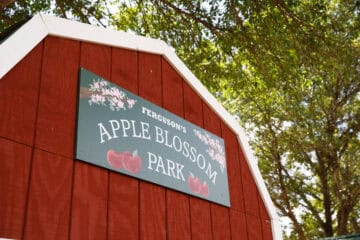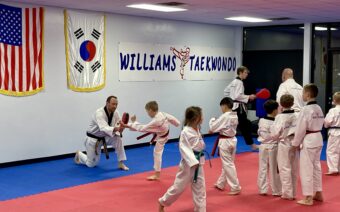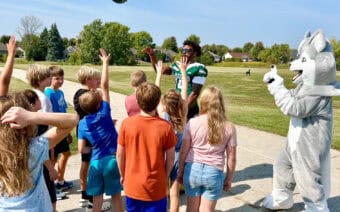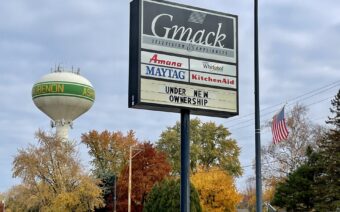
October 21, 2024
OSHKOSH – In 1949, Richard Verhoeven started Richard’s School of Dance on Waugoo Avenue in Oshkosh with just two students.
Seventy-six years later, his legacy lives on in the thousands of students he directly taught and the new generation of ownership.
Verhoeven’s approach to dance was clear: “The well-trained students of today are the stars of tomorrow.”
That remained when his daughter, Patricia Verhoeven Provost, took over ownership and again when Tricia Bayer became owner of the studio in 2009.
Bayer was no newcomer to the studio.
She said she started dancing as a Richard’s School of Dance student when she was “itty bitty,” dancing through high school.
At age 12, Bayer said she became a class demonstrator and then an assistant teacher before assuming full-time teaching responsibilities.
In 2009, at age 24, she assumed ownership of the studio intending to perpetuate everything Richard’s was known for: well-trained dancers, a welcoming and family-like environment and the fervent belief that dance is for all.
“Richard’s is for everyone,” Bayer said. “We believe everyone can dance regardless of age, gender or special needs. Dance is for everyone, and we have classes for everyone.”
Those classes, Bayer said, include ones for parents and newborns, a variety of dance disciplines, adults and even adaptive dance for individuals with special needs or disabilities.
The class repertoire, she said, includes ballet, jazz, tap, hip hop, Irish and aerial arts, both aerial silks (with silks) and aerial lyra (with a hoop).
“Think of Cirque du Soleil,” Bayer said. “It’s about learning to dance in the air, and we have a curriculum that starts with the basics and goes all the way up. We have kids’ programs, which is unique, and most of our students are kids, though there are adults, too.”
Bayer said offerings are geared toward students who do it as part of their fitness routine, for performance or just for fun.
Richard’s newest additions, she said, include homeschool dance classes, fitness dance classes and adaptive dance through the Rhythm Works program.

As a mom who homeschools her two children, Bayer said she saw the opportunity to offer homeschool-specific classes during afternoons.
“A lot of families homeschool in the morning and want activities to do in the afternoons when public school students are in school,” she said. “The home school classes are offered in the afternoons before kids come streaming in after public schools let out.”
Bayer said she has had a great response to the dance fitness classes – which take dance, such as tap dance, and make it into a fitness program.
While tap dance fitness isn’t new, jazz fit and jazz dance are new to Richard’s dance fitness offerings, geared to individuals ages 18 and older.
And though adaptive dance is nothing new to Richard’s, offering the Rhythm Works class specifically, Bayer said, is.
“I just became certified in Rhythm Works about a year ago,” she said. “The whole program works with individuals with physical disabilities or who are on the autism spectrum and allows them to dance in a specialized environment.”
Welcome one, welcome all
Before incorporating Rhythm Works, Bayer said she has long offered adaptive dance primarily through private lessons – serving as a Children’s Long-Term Support (CLTS) provider for children with disabilities in Winnebago, Fond du Lac and Sheboygan counties, allowing students to take county-funded classes.
With Rhythm Works, Bayer said Richard’s now offers a younger kids’ program geared to ages 3 to 12 and a program for ages 13 to adult.
She said the current term is focused on hip-hop, but she will implement other dance disciplines as well.
Throughout the classes, Bayer said students learn to understand rhythm and beats.
“Some are working on finding balance and going from one foot to another,” she said. “Others are blind and working on finding spatial awareness. Even though these are group classes, we focus on each student’s needs to make it a match for them.”
Janet Graeble said her daughter Hannah, 34, has participated in dance at Richard’s for 23 years and is now participating in adaptive dance, as she is losing her memory as a result of Parkinson’s disease.
“It’s been awesome,” Graeble said. “Some of the girls she was with in the Special Olympics are doing the class as well, and she’s having a really good time.”
Graeble said they head to Richard’s every Sunday for the 4 p.m. class for an eight-week stretch. Then there will be a break before Hannah resumes adaptive dance with tap in January.
Graeble said she is grateful that there’s a way for Hannah to continue to participate in dance.
“Hannah grew up in the studio, and we’ve known Tricia since we’ve been doing dance,” she said.
Graeble said Hannah began taking adaptive dance when Verhoeven Provost owned the studio.
She said Bayer has perpetuated that mindset in each class since.
The adaptive dance courses feature some very basic and repetitive routines, which Graeble said is ideal for children with visual needs.
She said Bayer posts the routine on the studio portal so students with special needs can practice at home if they’d like, which is important as they are mostly visual learners.
“Tricia and her staff are so open-hearted with Hannah, encouraging her and pushing her a little more,” Graeble said. “Tricia has the patience of a saint with all the kids.”
Graeble said she is grateful Hannah can continue to enjoy dance and be just like anyone else in that regard.
“They take such pride in learning to do something their peers are doing, and that gives them an extra boost and self-confidence,” she said.
Dual locations
Richard’s marked its 15th year in the Kohler/Sheboygan market in 2024, which Bayer said she entered in response to a family’s request for Irish dance classes in the area.
“We brought it down there for their grandchildren, and we’ve been there ever since,” she said.
What began with an Irish dance offering, Bayer said, has since grown to all dance courses offered at the Oshkosh location, except for aerial dance.
Bayer said Richard’s moved its studio to a room at Sheboygan Senior Communities and not only provides dance classes on Saturdays for local children but also residents at the senior community for community enrichment.
She said she heads to Sheboygan to teach on Saturdays and teaches at the Oshkosh locations Monday through Thursday and Sundays.
Richard’s, Bayer said, has a team of about 12 teachers in Oshkosh, most of whom teach one to two nights a week.
In addition, Richard’s has several class demonstrators and assistant instructors – who are students that participate in a volunteer program to learn how to train and work.
At the end of the program, Bayer said they can participate in some testing that, if they pass, qualifies them to become an employee, if desired.
Bayer said teaching the majority of the coursework every night, “all night long,” keeps her busy.
Studio evolution
Richard’s current location on State Street is just around the corner from Richard’s original studio.
That studio began as a small upstairs studio combined with a waiting room.
When Verhoeven Provost took over the business, Bayer said she purchased the downstairs portion of that location and created a designated waiting room.
In 1999, Bayer said Richard’s moved to its current location on State Street to enjoy a big studio and a small studio.
Since she purchased the business, Bayer said it has grown to feature three studios and a waiting room – which is often abuzz with activity with dancers (and parents) coming and going.
She said it’s a great representation of the tone Richard’s sets from the time students enter the door.
“I’ve seen students talk to each other in the lobby, asking each other things like, ‘I didn’t quite understand that step. Can you show me?’” Jennifer Peterson, a former dancer and mom of a current dance student, said. “It’s not just the teachers who are encouraging.”
A family atmosphere
Bayer said she works really hard to instill a welcoming environment and family-first atmosphere at Richard’s School of Dance.
Peterson said dancing at Richard’s is not only about continuing a tradition but being part of a family – and she should know, as her daughter, Alayna, is the third generation of students in her family to dance at Richard’s.
Peterson said her mom, Laurie Rasey, and sister, Donna King, danced under Verhoeven.
She said she danced at Richard’s in the 1980s and 1990s under Verhoeven Provost.
Peterson said Alayna – who is 15 and a sophomore in high school – has been dancing at Richard’s since she was four, marking her 12th year of dancing under Bayer.
“It’s a tradition, but it’s also the family atmosphere that Richard’s infuses into the studio,” Peterson said. “The students make connections, but we’ve made connections with families, too, and do things outside of dance.”
Peterson said she appreciates the non-competitive approach to dance that Richard’s provides and the ongoing mindset that everyone can dance.
The reminder worked, as Peterson said she returned to tap dancing last year after a 30-plus-year hiatus.
“It helps that the teachers are very encouraging and positive,” she said. “Tap was always my favorite. I love the sound of it, the intricacy of it and I plan to stick with it.”
Peterson said Alayna has found a home at Richard’s – choosing dance as her sport, participating in tap, jazz, ballet, modern and lyrical.
She said Alayna is also really enjoying the kickline class and plans to pursue becoming a “Richardette” (a play off Rockettes).

Peterson said her daughter was never drawn to participation in soccer or t-ball but found her place in dance.
She said Alayna has become a class demonstrator, assisting with adaptive dance classes as well.
“She tells people, ‘Dance is my thing,’” Peterson said.
Peterson said she appreciates that Alayna has not only learned dance techniques but also patience, teamwork, integrity and other lifelong skills and values.
What’s popular now?
Bayer said the type of dance that rises to the top of the popularity list fluctuates from year to year.
One year, it’s tap; the next, hip hop; and the next year, aerial, she said.
“It’s really about what’s on social media and television,” she said. “When there was breakdancing at the Olympics, it created a huge interest in hip-hop dance as a result. It really depends on what people see.”
Right now, Bayer said it’s a mix.
The little kids’ classes through the Discover Dance program, she said, focus on a conceptual learning approach to what dance is versus focusing on a specific type of dance.
“Our concept right now is focused on the concept of size – dancing big or dancing small,” she said. “It helps the younger students understand what dance is before going into tap, jazz or ballet.”
Regardless of which type of dance a student pursues, Bayer said Richard’s is focused on teaching proper technique and the idea of coming to dance versus coming to learn a dance.
“They learn to dance, and not just to learn a dance for an end-of-year performance,” she said. “We teach music theory, understanding technique and improvisation and dancing with clarity. We also talk about the dancer as a whole, who they are as a performer, a student, a friend. Training is not just a curriculum but the whole aspect of learning to be someone good in society.”
Though the studio attracted about 600 students across locations pre-COVID, the Richard’s family today, Bayer said, is about 500 students.
Bayer said participation is strong, primarily due to word of mouth – especially among generations of the same families, as well as social media and some advertising.
Seasonal productions
Bayer said she is proud to continue Richard’s tradition of a big performance each year, called Entertainment – which features two shows in one day.
All students perform in both shows, she said, working on choreography in January and putting pieces together for each dance discipline.
Bayer said she likens it to a Broadway performance, featuring curtain calls, special lighting, a live pianist and other touches to create a seamless experience.
“It’s not a mere dance recital but a dance performance, and it seamlessly goes from number to number,” she said.
In addition, Bayer said several dancers participate in the Annual Holiday Showcase for the community, through which students pick music and choreograph their own pieces with holiday music, record those performances and send the recordings to nursing homes and assisted living facilities around the state.
“It’s a great way to give back to the community while students work on their skills,” she said.
Bayer said community is also at the forefront of the work of Richard’s Performance Company (RPC), a nonprofit youth organization whose main purpose is to give back to the community through the arts.
RPC members, she said, perform winter and spring shows for the community, traveling to assisted living facilities, nursing homes and community enrichment events throughout the Christmas season to share the joy of dance and the arts.
“Richard’s is all about keeping the traditions while also growing,” Bayer said. “Because of the world we’re in, where things are constantly evolving, it’s super important to do both.”
 Ferguson’s Family of Farms celebrates decades-long legacy in western Wisconsin
Ferguson’s Family of Farms celebrates decades-long legacy in western Wisconsin Van Ert Electric moves into new corporate office
Van Ert Electric moves into new corporate office







